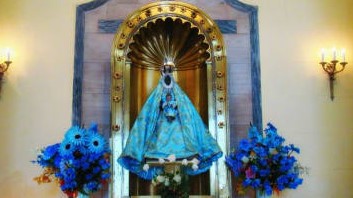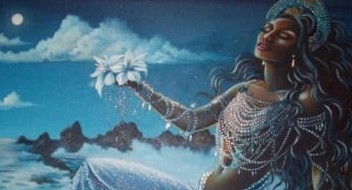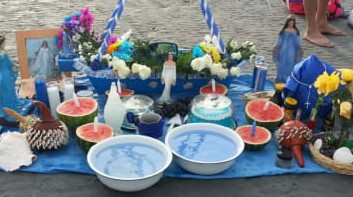All About Yemaya: Learn all her ways, the characteristics of her children, the prayer that Yemaya likes, and the types of offerings that are given to her.
In the Yoruba religion, there are different orishas, or deities, who are responsible for contact with human beings to offer their help.
Each of these orishas has different tastes, characteristics, phrases, and prohibitions, so before attending to or praying to any Yoruba deity, you should understand each of them.
Who is Yemaya?
She is a deity of the Yoruba religion and an orisha of the Egba people, characterized by her association and direct relationship with the goddess of the sea.
She is considered the deity of women and fertility. Many say she is the most powerful orisha, but due to her strong personality, she eventually lost her hegemony and was given the oceans.
History of Yemaya: Origins in the Yoruba Religion
The history of Yemaya dates back to the traditional Yoruba religion of Nigeria, where she was known as Yemoja, an orisha associated with the Ogun River. With the forced arrival of millions of Africans to the American continent during slavery, her cult merged with elements of Catholicism, giving rise to Santeria.
In the Catholic Religion

- In this religion, we find the Virgin of Regla as the syncretism of this deity, stemming from the cultural crossover and the rejection of the Yoruba:
- She is the owner and protector of a town located on the shores of Haba Bay.
Her colors, like those of the Catholic Church, are blue and white.
In Spiritism
In Spiritism, the same saints are not mentioned, however, this orisha is associated with Maria Lionza. Her characteristics include:
- She is the monarch of forty legions, each made up of ten thousand spirits.
- She is considered the Goddess of Nature and Love.
- Owner of lakes, rivers, and waterfalls.
- She is prayed to for financial problems, for love, and for cleansing.
The spiritual significance of Yemayá goes beyond her role as a water deity. She represents feminine power, creation, ancestral wisdom, and protection. Many faithful turn to her in times of emotional need, family problems, or when seeking spiritual comfort.
Yemayá in Cuban Santeria
In Santeria, Yemayá is syncretized with Our Lady of Regla. She is depicted as a majestic woman dressed in blue and white, colors that symbolize the sea and purity. She is considered the orisha of the sea and motherhood, and is believed to protect her children with strength and gentleness.
What does it mean when she speaks to you?

When she appears to you, it is a general symbolism that someone is seeking protection or a blessing, an experience where feelings surface due to the deep desire awakened by seeing her.
It implies that benefits are approaching that will be a great and important step for your life, whether it involves monetary matters, conflict resolution (with people or internal conflicts), emotional problems, difficulties, among other aspects that cause concern and that you must overcome.
What is her day?
Yemayá’s day is celebrated on September 7th in many regions of the Caribbean and Latin America, although in Brazil, her main holiday is on February 2nd. During these dates, offerings, processions, and rituals are held on beaches to honor her energy and ask for her blessing.
On this day, people line up to receive healings from the priests of Umbanda and Candomblé, religions that also pay homage to her.
How to ask her?
If you don’t know how to communicate with her to carry out a request or favor, below are the most important steps you should follow, always maintaining the respect the deity deserves:
- The first thing you must do is have or prepare the orisha’s altar.
- You must pronounce her name while touching the floor and then kiss her fingertips, as a symbol of respect.
- When greeting her, do so with great respect, repeating “Yemanjá, Yemaja, Yemaya Olokún.”
- Place the offerings on the altar in front of her figure.
- Say the prayer for the request you wish to make.
What are her offerings?

Each orisha has different tastes, so before attending to them, it is best to check that what you are about to offer or give is to their liking, since the deities are very delicate with this.
If you still don’t know or aren’t sure what you can truly offer to the orisha, here’s a list:
- Shrimp.
- Capers.
- Lettuce.
- Hard-boiled eggs.
- Tomato and chard.
- Ekó or corn tamale wrapped in banana leaves.
- Olelé or black-eyed peas or tapé beans made into a paste with ginger, garlic, and onion.
- Balled green plantains or yams with okra.
- Black beans.
- Palanquetas of gofio with sugarcane syrup.
- Burnt coconut and brown sugar.
- Whole fish.
Fruits
- Melon.
- Watermelon.
- Pineapples.
- Papayas.
- Grapes.
- Water pears.
- Apples.
- Oranges.
- Sugarcane molasses.
Sacrifices or immolations
Rams.
Ducks.
Hens or Angolan hens.
Pigeons.
Quails.
Geese.
Sus Ewe
- Royal itamo.
- Lettuce.
- White peregun.
- Atiponlá,
- Marjoram.
- Corn on the cob.
- Blackberry.
- Water flower.
- Indigo herb.
- Watercress.
- Verbena.
- Malanguilla.
- Umbrella.
- Prodigiosa.
- Fern.
- Cockroach.
- Malanga.
- Canutillo.
- Basil.
- Mint.
- Buttercup.
Easy-to-Prepare Offerings for Yemayá
Offerings for Yemayá are a way to give thanks or ask for favors. Some easy ones to make include:
- Fresh fruits (especially melon, watermelon, and grapes)
- Sweets and rice pudding
- White and blue flowers
- Blue and white candles
These offerings are placed on altars or given directly to the sea.
How to Make an Altar to Yemayá
Creating an altar dedicated to Yemayá is a way to keep her energy present in your daily life. It includes:
- A blue or white tablecloth
- Images or statuettes of Yemayá
- Candles and flowers
- Water in a container or seashells
- Personal offerings
This space should be kept clean and filled with respect.
Colors and Symbols of Yemayá
Yemaya’s traditional colors are blue and white, and her most common symbols include:
- Seashells
- Starfish
- Boats
- Fish
These elements are present on altars and offerings, and symbolize the connection with the sea and abundance.
What you should avoid?
The Auyama, as the deity detests it.
What paths does this orisha have?
The paths of the orishas are a facet, in which the deity has the possibility of taking on different characteristics and qualities, with which she can offer us help, advice, or support in any situation you may be facing.
She has 26 paths, but that doesn’t mean the other orishas have the same number. Her paths are as follows:
- Yemayá Asesu.
- Yemayá Awoyó.
- Yemayá Akuará.
- Yemayá Okute or Okuti.
- Yemayá Ibu Konla.
- Yemayá Ashaba or Ayabá.
- Yemayá Mayaleo or Mayelewo.
- Yemayá Yembó or Yemú.
- Yemayá Ibu Okoto.
- Yemayá Ibu Oleyo.
- Yemayá Ibu Elowo.
- Yemaya Akere.
- Yemaya Oro.
- Yemaya Ataremawa.
- Yemaya Ibu Gunle.
- Yemaya Ibu Agana.
- Yemaya Ibu Akinomi.
- Yemaya Ibu Iña.
- Yemaya Oggún Ayipo.
- Yemaya Oggún Asomi.
- Yemaya Ibu Nodo.
- Yemaya Yamase.
- Yemaya Ibu Alaro.
- Yemaya Ibu Yabani.
- Yemaya Ibu Tinibu.
- Yemaya Lokún Nipa.
What are her children like?

Most sons are strong-willed, confident, and strong, although they can sometimes be a bit arrogant and impetuous with those around them, because like the sea, they tend to have a rather unstable attitude.
Men can seem a bit effeminate to other men, as they can lean somewhat toward feminine attitudes, without necessarily being homosexual.
They are people who forgive others if they are hurt or their trust is broken; however, they are resentful and will not forget what was done to them, so things will never be the same again.
In love, they are quite decisive and very direct; they will tell you how they feel without thinking much about it.
She ended up married to the orisha of the oracle, Orula, the great diviner of Ifa in the Yoruba religion.
The Patakies say that Orula had to make a long journey to a meeting of the Awo convened by the deity Olofin. However, the journey took longer than she had expected, and after running out of money, she decided to consult on her own with someone who needed her help.
Her wisdom, skill, and gift of divination led her to achieve successful results in solving problems through Diloggun.
On the way home, Orula came across rumors of a miraculous woman and diviner. His curiosity led him to disguise himself and search for that mysterious woman, eventually arriving at her own home.
When she discovered this, she clarified that she didn’t intend to die of hunger. However, Orula became upset and took her to Olofín.
He decreed that he would take care of the okpele, the ikines, and the Até of Ifá, but he would also be in charge of the Diloggun. Furthermore, every time she went out in her Oddun, the priests or babalawos had to pay homage to her.
Prayer to Yemaya
There are a variety of prayers for this orisha, however, each has a different purpose or objective, which will depend directly on your request. Below is one of the most popular prayers:
“Great Mother of the fluids of the earth,
immeasurable is your power,
as is your love for your children and the wisdom
with which you command the waters of the seas.
Strong is my prayer, Yemayá,
accept my request and keep the people who wish to harm me out of my reach,
as well as eradicate my fears.
Strong is my prayer, Yemayá,
do not allow sorrow to reach my residence,
and may your fortune be the most important thing I will receive.
Long live Yemayá. I trust you completely,
for you are the work of Olodumare on the existing plane.
Therefore, I turn to you, and I ask you to help me with my request.
Of course, if I am worthy of it.
So be it.”
Powerful Prayer to Yemayá for Love
One of the most common requests to Yemayá is related to love. Below is a powerful prayer you can use:
“Mother Yemayá, mistress of the waters and the heart, open my paths in love, cleanse my soul of past sadness, and fill me with sweetness to receive the one destined for me. Ashe.”
Differences between Yemayá and Oshún
Although both are female orishas, there are important differences:
- Yemayá: Mother of the sea, maternal force, protector, serious, and wise
- Oshún: Goddess of the river, associated with love, beauty, money, and sensuality
Many practitioners worship both for their complementary energies.
Yemayá and the sea: spirituality and energy
For many, the sea is a sacred place where they connect directly with Yemayá. It is believed that:
- The waves carry her messages
- The sound of the sea cleanses the soul
- Walking along the shore is a form of meditation guided by Yemayá
Tattoos and Representations of Yemayá
Yemayá tattoos are increasingly popular as an expression of faith and spiritual connection. They can include:
- Her face surrounded by water
- Boats and mermaids
- Phrases such as “Mother of the Sea” or “Yemayá Ashé”
Yemayá in Popular Culture and Music
In Afro-Cuban and Brazilian music, Yemayá is a recurring figure. There are traditional songs dedicated to her that are played on batá drums and sung in the Yoruba language. In Brazilian Candomblé, ritual dances are also performed in her honor.
We hope this article has been of interest to you and that it has helped you expand and grow your knowledge about this great orisha of the Yoruba religion.
